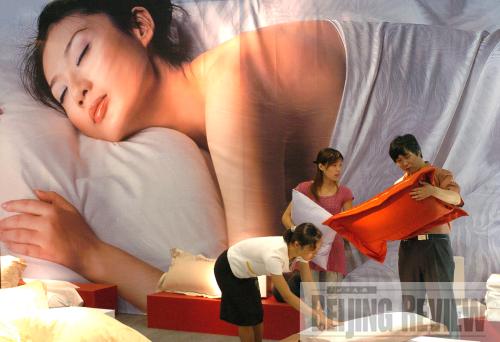|
 |
|
DREAMING OF TEXTILES: Textile import and export shows are important channels for Lu Lili to communicate with her clients and suppliers (XINHUA) |
Lu Lili, a 32-year-old woman, lives a life very similar to that of other housewives. Things change late at night, however, after she checks her inbox to keep synchronized with her European customers.
Lu owns a small textile-trading company in Nantong, Jiangsu Province, one of the major household textile bases in China. Her company, Nantong Mingyu Trading Co. Ltd.has only three staff, but it exports hotel textiles mainly to Europe and the Middle East—something that has brought Lu ever closer to her lifelong pursuit.
Lu began her trading career at a Sino-Japanese textile company in 2000 after graduation from university. Having been in the textile trade for nine years, Lu learned everything about textile trading.
Initially, her job at a Sino-Japanese company was to translate trading contracts and communicate with overseas business partners. And after a year, she was able to deal with an increased workload, and her salary also increased. In the first year, she earned 30,000 yuan ($4,411)—much higher than her college classmates in other industries. In 2004, the last year before she left her first job, her annual salary nearly tripled to more than 80,000 yuan ($11,764.7).
But she still aspired to a higher career target. Because the textile joint venture only produced raw materials for making shirts, she found the market too small. "Although I tried hard to develop new customers, I did not see much increase," Lu said.
Later, she was invited to start trading for a local hotel linen and textile manufacturer. She immediately accepted it, believing it would give her a necessary opportunity to start her own business someday.
"I found the hotel textile business promising and profitable," said Lu. "Since all the hotels needed to replace their linen and textile almost every half year, there was hence a big and continuous demand."
Then, by March 2008, when she was able to make a profit of several hundreds million yuan for her boss, Lu was also ready for her own trading company.
"I had never changed my mind when it came to doing trading business," Lu said. "China is rich in commodities—whatever the overseas customers want to import, we are able to provide."
What's more, she added, confidence comes from the government's unyielding support, which was reflected on the evolution of export tax rebate policies.
According to Lu, when she first began her career in 2000, it usually took two, or even three years, for enterprises to get export tax rebates. By 2004, it is shortened to, at most, half a year.
The high efficiency in tax rebates encouraged more enterprises to engage in exports, said Lu.
The tax rebate rate for textiles remained at 13 percent from 2000 to 2004, and the exchange rate between Chinese yuan and U.S. dollar also remained stable.
But from the second half of 2005 to 2007, as part of the country's efforts to phase out outdated textile production capacity, reduction in the tax rebate rate began to accelerate much more than before. The rebate rate on the export of textiles was cut to 11 percent from 13 percent in September 2006.
Since 2007, Chinese textile enterprises have suffered greatly from the continuous appreciation of yuan, the impact of the U.S. sub-prime mortgage crisis and the ensuing economic difficulties, and increasing prices in raw materials and labor.
The cut of the export tax rebate has further squeezed the paper-thin profit space, almost the last hope for the textile industry.
Last year, China increased the export tax rebate for textiles to 16 percent to help exporters ride out of economic predicament.
"The increase in export tax rebate was undoubtedly a timely support for the textile industry," noted Lu, "including the trading companies, like mine."
"My net profit grew only 6 to 7 percent, and if the tax rebate got even lower, it would be hard to survive," she added. "And the situation would be even more difficult for manufacturers."
Meanwhile, Lu was rather concerned about the fierce and low-end competition in China's textile industry.
"Now e-commerce has squeezed out the manufacturer's least share of profit," she added. "The overcapacity and price war have made textile companies much less profitable than before."
Her company only exports high-end products. "The high-end products were still profitable, and many of my products went to internationally acclaimed hotels, like Grand Hyatt and Hilton," she said.
"The trading company could only thrive by relying on high quality and professional service," she said. This is also her business philosophy built after nine years of experience.
"On the e-commerce website, the price was rather transparent—I outdistance my competitors by providing value-added service," Lu said.
Her self-assuredness is unquestionable. "The world hospitality industry will grow and their needs for textile will never die out," she said. "I am confident in the business." | 